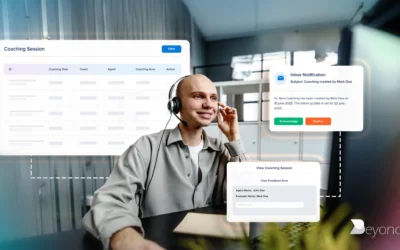Over the past decade, call centers have realized the need to keep their hotlines available 24/7 to improve customer experience and satisfaction. To do this, they introduced AI-based chatbots. However, the robotic, machine-like responses weren’t well received by customers. To address this issue, conversational AI in customer service was implemented.
Once contact centers began adopting this advanced AI model, customer satisfaction improved, as customers felt more valued, and the centers saw significant cost savings while still maintaining a personal touch. And this is how conversational AI gained its momentum, and now it’s a standard feature in every contact center. In addition, according to a Gartner report, by 2026, contact centers will reduce costs by as much as $80 billion through the use of conversational AI in customer service.
The Core of Conversational AI Call Center
In a call center, you can find numerous AI systems utilized for automating schedules, transforming speech to text, and supporting agents. Among them, there’s conversational AI that understands and responds to human language in a natural way, just like a human agent.
Mostly, people think of conversational AI as chatbots, and to some extent, it’s true. But, this AI also helps in responding to customer queries over call. It uses numerous high-end technologies for this purpose, such as:
- Natural Language Generation (NLG)
- Natural Language Understanding (NLU)
- Speech Recognition
- Text-to-speech (TTS)
All these technologies create the core of conversational AI, due to which call centers gain growth in their CSAT, AHT, FCR, NPS, and other KPIs.
Actionable Insights at Your Fingertips
How Conversational AI in Customer Service Elevates Experience
For decades, contact centers have been using only human agents to interact with customers. But, when conversational AI came into the game, major CX aspects get transformed. There’s seamless communication, better KPIs achievement, and engaging customer experience.
In addition, there are many more factors that conversational AI addresses, and the top five of them are listed below.
1: Personalizes Customer Interaction
With the capabilities of contextual understanding and proactive assistance, conversational AI in customer service does wonders. It remembers all the past conversations with the customers, which helps to provide relevant answers. Also, the customers don’t have to repeat themselves, and it contributes to the growth of the CSAT score.
Additionally, conversational AI uses pattern-learning techniques to understand customer behavior. It can anticipate issues promptly and offers solutions in the way that customer understands. Moreover, you can also integrate it with your omnichannel communication mechanisms. It’ll help the AI to centralize customer information and resolve queries across channels.
As a result, every customer receives relevant results according to their previous and current preferences.
2: Maximizes Contact Center Availability
If your contact center is not available 24/7, then your possibility to survive in a competitive market lies on the floor. Mitigating this low possibility risk is another key advantage of conversational AI contact centers. It offers you the ability to maximize availability every single second.
You can use this AI for chatbots, calls, and virtual assistants. The customers can contact you anytime, and you’ll be there for them. In addition, your contact center will have a system that never rests and gets optimized with every new interaction to serve better the very next moment.
Moreover, it provides the capability to cater to customers across different time zones and locations. You can customize it for localization to communicate better in the customer’s native language. It will assuredly boost the customer’s morale, experience, and engagement.
3: Enhances Operational Efficiency
Conversational AI directly contributes to improving operational efficiency by eliminating repetitive manual tasks. It helps you free up the agents from resolving general and low-level queries and focus on the more complex ones.
Mainly, conversational AI in customer services focuses on the following three areas:
Answering FAQs
Under it, simple and straightforward customer queries get resolved, such as billing inquiries, account information, price and product details, and more.
Supporting order-associated conversations
Advanced AI systems seamlessly retrieve correct information, helping you answer order queries with real-time data. It supports addressing inquiries, such as shipment details, expected delivery date, and order status.
Basic technical troubleshooting
Artificial intelligence is now smart enough to help with resolving technical issues. It offers troubleshooting steps to customers by taking all required details into consideration. Mainly, network issues are resolved through this conversational AI call center mechanism.
4: Accurately Routes and Escalate Queries
When there are more advanced algorithms working behind conversational AI, it helps you effectively route and escalate queries. For this, it determines the complexity of the inquiry and decides whether to transfer it to a human agent. In addition, you can also integrate conversational AI with speech analytics software. It’ll help the mechanism to transfer customers to human agents in tense situations, requiring empathy.
Furthermore, conversational AI understands the context of the customer issue and correctly transfers it to the right department or agent. As a result, waiting time gets reduced, customers don’t have to repeat themselves and they receive appropriate resolution.
5: Offers Data-Driven and Real-Time Analytics
With every customer-conversational AI interaction, some data gets generated. You can analyze this data to discover the frequent issues, customer behavior, sentiments, and even their thoughts about your brand. Further, you can utilize all such details to refine your services and improve AI and human-based operations for better CSAT scores.
Additionally, with conversational AI customer service, you can leverage the following real-time analytics:
Speech and Text Analytics
The AI analyzes the customer’s speech and can help you convert it to text. You can utilize the text format to identify common issues and FQAs. It’ll help you refine your chatbot and virtual agent functionality.
Sentiment Analytics
Under the call center sentiment analysis factor, conversational AI supports the evaluation of patterns for describing customer behavior and their emotional level. With these details, you can understand whether your customers are satisfied, frustrated, or neutral with the services.
Service Quality Analytics
Over time, AI aids you in improving the responses and query processing approach. As a result, you make services better and curate more accurate resolutions.
Refine Your Customer Service KPIs
The Future of Conversational AI Contact Center: Upcoming Developments and Innovation
Conversational AI for customer service isn’t limited to only low-level interactions. In the future, you’ll see its next-level upgrade, handling complex queries, requiring emotional intelligence and multilingual capabilities. In addition, its integration with other business systems and AI models will assuredly enhance your CX KPIs.
Additionally, you’ll hands-on with some amazing and avant-garde functionalities, such as:
- AI analyzes the product images and videos sent by customers to decide whether to place a return or refund per business policies.
- Supporting agents, providing video call assistance in determining the right sentiments of the customers.
- Gathering data about customers from all available sources and centralizing the details.
- The conversational AI will seamlessly carry conversations from one of the omnichannel platforms to another.
- Besides all such advancements, there can be more. But, there’s only one way to leverage them accurately, if you start with a conversational ai call center now.
Wrapping Up
Conversational AI is a game-changer in the realm of contact centers. It’s working as a primary interaction for customers and also supporting agents for improved efficiency. In addition, it offers numerous benefits, from personalizing user experiences and offering analytics to maximizing availability. Moreover, the upcoming development in this technology will elevate customer service to the next level. Therefore, it’s time to make this avant-garde AI tech a part of your contact center.
Frequently Asked Questions
How does Conversational AI enhance response time?
Conversational AI offers instant responses to customers based on their current queries, historical data, and custom business policies. In addition, you can also refine the AI to curate custom responses within minimal time to rapidly cater to each user.
Is conversational AI capable of understanding multiple languages?
Yes, conversational AI can understand multiple languages to help contact centers with people in different geographical areas and communities. In addition, in the future, you’ll see more advancements in this feature, understanding and processing multi-language jargon, slang, idioms, and more.
Can conversational AI replace human agents in contact centers?
Currently, conversational AI is mostly used to handle low-level or L1 queries in a call center. It works as a supporting mechanism for agents to reduce workload and appropriately route the calls/chats, if necessary.



